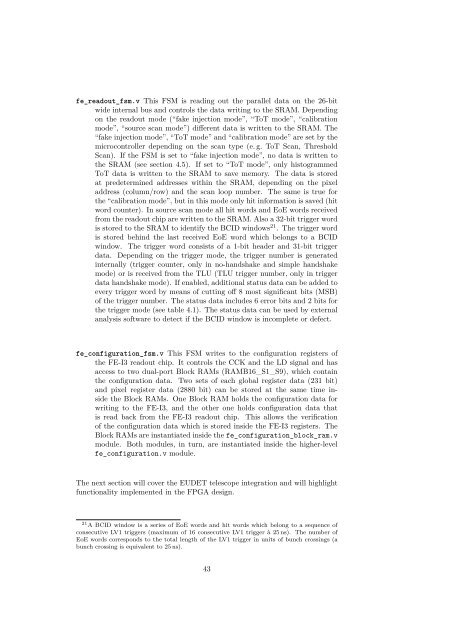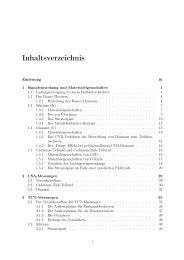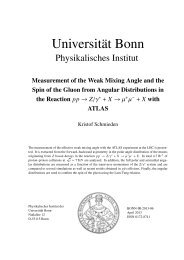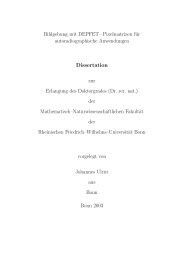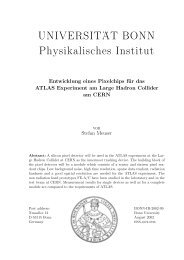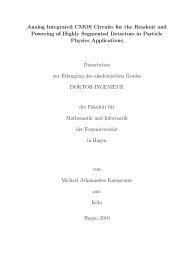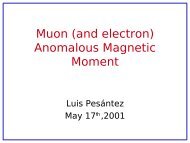Jens Janssen Diploma Thesis - Prof. Dr. Norbert Wermes ...
Jens Janssen Diploma Thesis - Prof. Dr. Norbert Wermes ...
Jens Janssen Diploma Thesis - Prof. Dr. Norbert Wermes ...
Create successful ePaper yourself
Turn your PDF publications into a flip-book with our unique Google optimized e-Paper software.
fe_readout_fsm.v This FSM is reading out the parallel data on the 26-bitwide internal bus and controls the data writing to the SRAM. Dependingon the readout mode (“fake injection mode”, “ToT mode”, “calibrationmode”, “source scan mode”) di erent data is written to the SRAM. The“fake injection mode”, “ToT mode” and “calibration mode” are set by themicrocontroller depending on the scan type (e. g. ToT Scan, ThresholdScan). If the FSM is set to “fake injection mode”, no data is written tothe SRAM (see section 4.5). If set to “ToT mode”, only histogrammedToT data is written to the SRAM to save memory. The data is storedat predetermined addresses within the SRAM, depending on the pixeladdress (column/row) and the scan loop number. The same is true forthe “calibration mode”, but in this mode only hit information is saved (hitword counter). In source scan mode all hit words and EoE words receivedfrom the readout chip are written to the SRAM. Also a 32-bit trigger wordis stored to the SRAM to identify the BCID windows 21 . The trigger wordis stored behind the last received EoE word which belongs to a BCIDwindow. The trigger word consists of a 1-bit header and 31-bit triggerdata. Depending on the trigger mode, the trigger number is generatedinternally (trigger counter, only in no-handshake and simple handshakemode) or is received from the TLU (TLU trigger number, only in triggerdata handshake mode). If enabled, additional status data can be added toevery trigger word by means of cutting o 8 most significant bits (MSB)of the trigger number. The status data includes 6 error bits and 2 bits forthe trigger mode (see table 4.1). The status data can be used by externalanalysis software to detect if the BCID window is incomplete or defect.fe_configuration_fsm.v This FSM writes to the configuration registers ofthe FE-I3 readout chip. It controls the CCK and the LD signal and hasaccess to two dual-port Block RAMs (RAMB16_S1_S9), which containthe configuration data. Two sets of each global register data (231 bit)and pixel register data (2880 bit) can be stored at the same time insidethe Block RAMs. One Block RAM holds the configuration data forwriting to the FE-I3, and the other one holds configuration data thatis read back from the FE-I3 readout chip. This allows the verificationof the configuration data which is stored inside the FE-I3 registers. TheBlock RAMs are instantiated inside the fe_configuration_block_ram.vmodule. Both modules, in turn, are instantiated inside the higher-levelfe_configuration.v module.The next section will cover the EUDET telescope integration and will highlightfunctionality implemented in the FPGA design.21 ABCIDwindowisaseriesofEoEwordsandhitwordswhichbelongtoasequenceofconsecutive LV1 triggers (maximum of 16 consecutive LV1 trigger à 25 ns). The number ofEoE words corresponds to the total length of the LV1 trigger in units of bunch crossings (abunch crossing is equivalent to 25 ns).43


